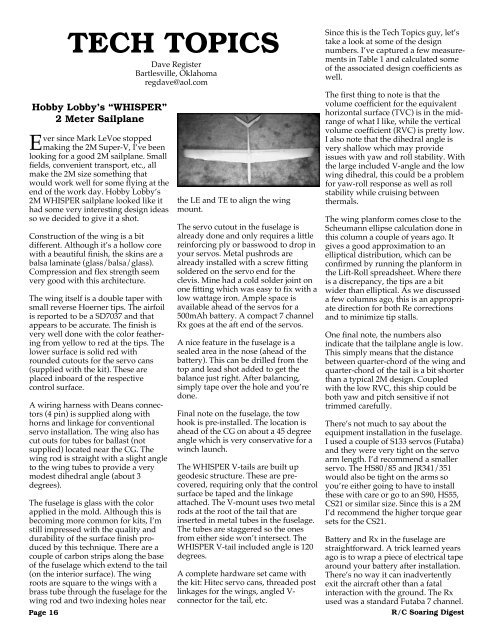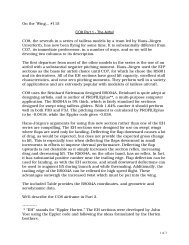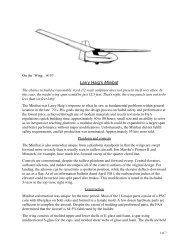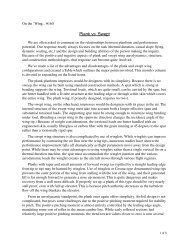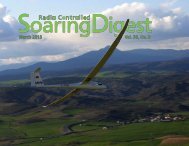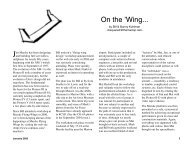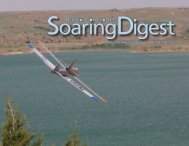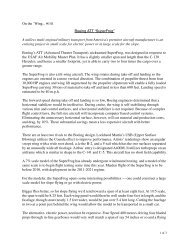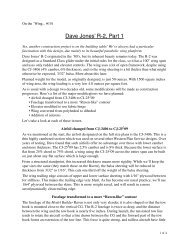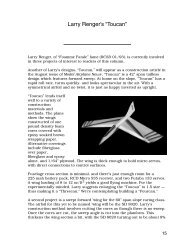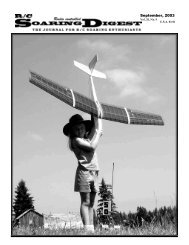Create successful ePaper yourself
Turn your PDF publications into a flip-book with our unique Google optimized e-Paper software.
Hobby Lobby’s “WHISPER”2 Meter SailplaneEver since Mark LeVoe stoppedmaking the 2M Super-V, I’ve beenlooking for a good 2M sailplane. Smallfields, convenient transport, etc., allmake the 2M size something thatwould work well for some flying at theend of the work day. Hobby Lobby’s2M WHISPER sailplane looked like ithad some very interesting design ideasso we decided to give it a shot.Construction of the wing is a bitdifferent. Although it’s a hollow corewith a beautiful finish, the skins are abalsa laminate (glass/balsa/glass).Compression and flex strength seemvery good with this architecture.The wing itself is a double taper withsmall reverse Hoerner tips. The airfoilis reported to be a SD7037 and thatappears to be accurate. The finish isvery well done with the color featheringfrom yellow to red at the tips. Thelower surface is solid red withrounded cutouts for the servo cans(supplied with the kit). These areplaced inboard of the respectivecontrol surface.A wiring harness with Deans connectors(4 pin) is supplied along withhorns and linkage for conventionalservo installation. The wing also hascut outs for tubes for ballast (notsupplied) located near the CG. Thewing rod is straight with a slight angleto the wing tubes to provide a verymodest dihedral angle (about 3degrees).The fuselage is glass with the colorapplied in the mold. Although this isbe<strong>com</strong>ing more <strong>com</strong>mon for kits, I’mstill impressed with the quality anddurability of the surface finish producedby this technique. There are acouple of carbon strips along the baseof the fuselage which extend to the tail(on the interior surface). The wingroots are square to the wings with abrass tube through the fuselage for thewing rod and two indexing holes nearPage 16TECH TOPICSDave RegisterBartlesville, Oklahomaregdave@aol.<strong>com</strong>the LE and TE to align the wingmount.The servo cutout in the fuselage isalready done and only requires a littlereinforcing ply or basswood to drop inyour servos. Metal pushrods arealready installed with a screw fittingsoldered on the servo end for theclevis. Mine had a cold solder joint onone fitting which was easy to fix with alow wattage iron. Ample space isavailable ahead of the servos for a500mAh battery. A <strong>com</strong>pact 7 channelRx goes at the aft end of the servos.A nice feature in the fuselage is asealed area in the nose (ahead of thebattery). This can be drilled from thetop and lead shot added to get thebalance just right. After balancing,simply tape over the hole and you’redone.Final note on the fuselage, the towhook is pre-installed. The location isahead of the CG on about a 45 degreeangle which is very conservative for awinch launch.The WHISPER V-tails are built upgeodesic structure. These are precovered,requiring only that the controlsurface be taped and the linkageattached. The V-mount uses two metalrods at the root of the tail that areinserted in metal tubes in the fuselage.The tubes are staggered so the onesfrom either side won’t intersect. TheWHISPER V-tail included angle is 120degrees.A <strong>com</strong>plete hardware set came withthe kit: Hitec servo cans, threaded postlinkages for the wings, angled V-connector for the tail, etc.Since this is the Tech Topics guy, let’stake a look at some of the designnumbers. I’ve captured a few measurementsin Table 1 and calculated someof the associated design coefficients aswell.The first thing to note is that thevolume coefficient for the equivalenthorizontal surface (TVC) is in the midrangeof what I like, while the verticalvolume coefficient (RVC) is pretty low.I also note that the dihedral angle isvery shallow which may provideissues with yaw and roll stability. Withthe large included V-angle and the lowwing dihedral, this could be a problemfor yaw-roll response as well as rollstability while cruising betweenthermals.The wing planform <strong>com</strong>es close to theScheumann ellipse calculation done inthis column a couple of years ago. Itgives a good approximation to anelliptical distribution, which can beconfirmed by running the planform inthe Lift-Roll spreadsheet. Where thereis a discrepancy, the tips are a bitwider than elliptical. As we discusseda few columns ago, this is an appropriatedirection for both Re correctionsand to minimize tip stalls.One final note, the numbers alsoindicate that the tailplane angle is low.This simply means that the distancebetween quarter-chord of the wing andquarter-chord of the tail is a bit shorterthan a typical 2M design. Coupledwith the low RVC, this ship could beboth yaw and pitch sensitive if nottrimmed carefully.There’s not much to say about theequipment installation in the fuselage.I used a couple of S133 servos (Futaba)and they were very tight on the servoarm length. I’d re<strong>com</strong>mend a smallerservo. The HS80/85 and JR341/351would also be tight on the arms soyou’re either going to have to installthese with care or go to an S90, HS55,CS21 or similar size. Since this is a 2MI’d re<strong>com</strong>mend the higher torque gearsets for the CS21.Battery and Rx in the fuselage arestraightforward. A trick learned yearsago is to wrap a piece of electrical tapearound your battery after installation.There’s no way it can inadvertentlyexit the aircraft other than a fatalinteraction with the ground. The Rxused was a standard Futaba 7 channel.R/C Soaring Digest


